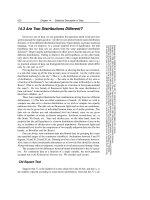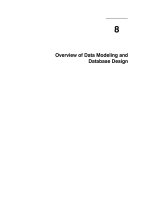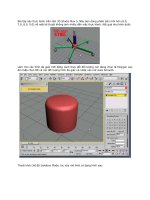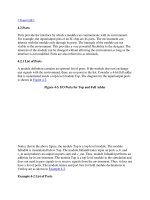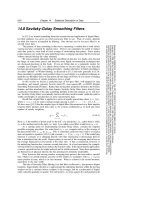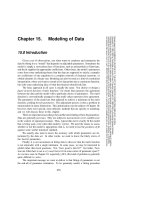Tài liệu Modeling of Data part 4 pptx
Bạn đang xem bản rút gọn của tài liệu. Xem và tải ngay bản đầy đủ của tài liệu tại đây (168.4 KB, 6 trang )
666
Chapter 15. Modeling of Data
Sample page from NUMERICAL RECIPES IN C: THE ART OF SCIENTIFIC COMPUTING (ISBN 0-521-43108-5)
Copyright (C) 1988-1992 by Cambridge University Press.Programs Copyright (C) 1988-1992 by Numerical Recipes Software.
Permission is granted for internet users to make one paper copy for their own personal use. Further reproduction, or any copying of machine-
readable files (including this one) to any servercomputer, is strictly prohibited. To order Numerical Recipes books,diskettes, or CDROMs
visit website or call 1-800-872-7423 (North America only),or send email to (outside North America).
*chi2=0.0; Calculate χ
2
.
*q=1.0;
if (mwt == 0) {
for (i=1;i<=ndata;i++)
*chi2 += SQR(y[i]-(*a)-(*b)*x[i]);
sigdat=sqrt((*chi2)/(ndata-2)); For unweighted data evaluate typ-
ical sig using chi2,andad-
just the standard deviations.
*siga *= sigdat;
*sigb *= sigdat;
} else {
for (i=1;i<=ndata;i++)
*chi2 += SQR((y[i]-(*a)-(*b)*x[i])/sig[i]);
if (ndata>2) *q=gammq(0.5*(ndata-2),0.5*(*chi2)); Equation (15.2.12).
}
}
CITED REFERENCES AND FURTHER READING:
Bevington, P.R. 1969,
Data Reduction and Error Analysis for the Physical Sciences
(New York:
McGraw-Hill), Chapter 6.
15.3 Straight-Line Data with Errors in Both
Coordinates
If experimental data are subject to measurement error not only in the y
i
’s, but also in
the x
i
’s, then the task of fitting a straight-line model
y(x)=a+bx (15.3.1)
is considerably harder. It is straightforward to write down the χ
2
merit function for this case,
χ
2
(a, b)=
N
i=1
(y
i
− a − bx
i
)
2
σ
2
yi
+b
2
σ
2
xi
(15.3.2)
where σ
xi
and σ
yi
are, respectively, the x and y standard deviations for the ith point. The
weighted sum of variances in the denominator of equation (15.3.2) can be understood both
as the variance in the direction of the smallest χ
2
between each data point and the line with
slope b, and also as the variance of the linear combination y
i
− a − bx
i
of two random
variables x
i
and y
i
,
Var(y
i
− a − bx
i
)=Var(y
i
)+b
2
Var(x
i
)=σ
2
yi
+b
2
σ
2
xi
≡1/w
i
(15.3.3)
The sum of the square of N random variables, each normalized by its variance, is thus
χ
2
-distributed.
We want to minimize equation (15.3.2) with respect to a and b. Unfortunately, the
occurrence of b in the denominator of equation (15.3.2) makes the resulting equation for
the slope ∂χ
2
/∂b =0nonlinear. However, the corresponding condition for the intercept,
∂χ
2
/∂a =0, is still linear and yields
a =
i
w
i
(y
i
− bx
i
)
i
w
i
(15.3.4)
where the w
i
’s are defined by equation (15.3.3). A reasonable strategy, now, is to use the
machinery of Chapter 10 (e.g., the routine brent) for minimizing a general one-dimensional
function to minimize with respect to b, while using equation (15.3.4) at each stage to ensure
that the minimum with respect to b is also minimized with respect to a.
15.3 Straight-Line Data with Errors in Both Coordinates
667
Sample page from NUMERICAL RECIPES IN C: THE ART OF SCIENTIFIC COMPUTING (ISBN 0-521-43108-5)
Copyright (C) 1988-1992 by Cambridge University Press.Programs Copyright (C) 1988-1992 by Numerical Recipes Software.
Permission is granted for internet users to make one paper copy for their own personal use. Further reproduction, or any copying of machine-
readable files (including this one) to any servercomputer, is strictly prohibited. To order Numerical Recipes books,diskettes, or CDROMs
visit website or call 1-800-872-7423 (North America only),or send email to (outside North America).
∆
χ
2
= 1
σ
a
A
B
σ
b
0
b
a
s
r
Figure 15.3.1. Standard errors for the parameters a and b. The point B can be found by varying the
slope b while simultaneously minimizing the intercept a. This gives the standard error σ
b
,andalsothe
value s. The standard error σ
a
can then be found by the geometric relation σ
2
a
= s
2
+ r
2
.
Because of the finite error bars on the x
i
’s, the minimum χ
2
as a function of b will
be finite, though usually large, when b equals infinity (line of infinite slope). The angle
θ ≡ arctan b is thus more suitable as a parametrization of slope than b itself. The value of χ
2
will then be periodic in θ with period π (not 2π!). If any data points have very small σ
y
’s
but moderate or large σ
x
’s, then it is also possible to have a maximum in χ
2
near zero slope,
θ ≈ 0. In that case, there can sometimes be two χ
2
minima, one at positive slope and the
other at negative. Only one of these is the correct global minimum. It is therefore important
to have a good starting guess for b (or θ). Our strategy, implemented below, is to scale the
y
i
’s so as to have variance equal to the x
i
’s, then to do a conventional (as in §15.2) linear fit
with weights derived from the (scaled) sum σ
2
yi
+σ
2
xi
. This yields a good starting guess for
b if the data are even plausibly related to a straight-line model.
Finding the standard errors σ
a
and σ
b
on the parameters a and b is more complicated.
We will see in §15.6 that, in appropriate circumstances, the standard errors in a and b are the
respective projections onto the a and b axes of the “confidence region boundary” where χ
2
takes on a value one greater than its minimum, ∆χ
2
=1. In the linear case of §15.2, these
projections follow from the Taylor series expansion
∆χ
2
≈
1
2
∂
2
χ
2
∂a
2
(∆a)
2
+
∂
2
χ
2
∂b
2
(∆b)
2
+
∂
2
χ
2
∂a∂b
∆a∆b (15.3.5)
Becauseof the presentnonlinearityin b, however,analytic formulas for the second derivatives
are quite unwieldy; more important, the lowest-orderterm frequently gives a poor approxima-
tion to ∆χ
2
. Our strategy is therefore to find the roots of ∆χ
2
=1numerically, by adjusting
the value of the slope b away from the minimum. In the program below the general root finder
zbrent is used. It may occur that there are no roots at all — for example, if all error bars are
so large that all the data points are compatible with each other. It is important, therefore, to
make some effort at bracketing a putative root before refining it (cf. §9.1).
Because a is minimized at each stage of varying b, successful numerical root-finding
leads to a value of ∆a that minimizes χ
2
for the value of ∆b that gives ∆χ
2
=1.This(see
Figure 15.3.1) directly gives the tangent projection of the confidence region onto the b axis,
and thus σ
b
. It does not, however, give the tangent projection of the confidence region onto
the a axis. In the figure, we have found the point labeled B;tofindσ
a
we need to find the
668
Chapter 15. Modeling of Data
Sample page from NUMERICAL RECIPES IN C: THE ART OF SCIENTIFIC COMPUTING (ISBN 0-521-43108-5)
Copyright (C) 1988-1992 by Cambridge University Press.Programs Copyright (C) 1988-1992 by Numerical Recipes Software.
Permission is granted for internet users to make one paper copy for their own personal use. Further reproduction, or any copying of machine-
readable files (including this one) to any servercomputer, is strictly prohibited. To order Numerical Recipes books,diskettes, or CDROMs
visit website or call 1-800-872-7423 (North America only),or send email to (outside North America).
point A. Geometry to the rescue: To the extent that the confidence region is approximated
by an ellipse, then you can prove (see figure) that σ
2
a
= r
2
+ s
2
. The value of s is known
from having found the point B. The value of r follows from equations (15.3.2) and (15.3.3)
applied at the χ
2
minimum (point O in the figure), giving
r
2
=1
i
w
i
(15.3.6)
Actually, since b can go through infinity, this whole procedure makes more sense in
(a, θ) space than in (a, b) space. That is in fact how the following program works. Since
it is conventional, however, to return standard errors for a and b, not a and θ, we finally
use the relation
σ
b
= σ
θ
/ cos
2
θ (15.3.7)
We caution that if b and its standard error are both large, so that the confidenceregion actually
includes infinite slope, then the standard error σ
b
is not very meaningful. The function chixy
is normally called only by the routine fitexy. However, if you want, you can yourself
explore the confidenceregion by making repeated calls to chixy (whose argument is an angle
θ, not a slope b), after a single initializing call to fitexy.
A final caution, repeated from §15.0, is that if the goodness-of-fit is not acceptable
(returned probability is too small), the standard errors σ
a
and σ
b
are surely not believable. In
dire circumstances, you might try scaling all your x and y error bars by a constant factor until
the probability is acceptable (0.5, say), to get more plausible values for σ
a
and σ
b
.
#include <math.h>
#include "nrutil.h"
#define POTN 1.571000
#define BIG 1.0e30
#define PI 3.14159265
#define ACC 1.0e-3
int nn; Global variables communicate with
chixy.float *xx,*yy,*sx,*sy,*ww,aa,offs;
void fitexy(float x[], float y[], int ndat, float sigx[], float sigy[],
float *a, float *b, float *siga, float *sigb, float *chi2, float *q)
Straight-line fit to input data
x[1..ndat]
and
y[1..ndat]
with errors in both x and y, the re-
spective standard deviations being the input quantities
sigx[1..ndat]
and
sigy[1..ndat]
.
Output quantities are
a
and
b
such that y = a + bx minimizes χ
2
, whose value is returned
as
chi2
.Theχ
2
probability is returned as
q
, a small value indicating a poor fit (sometimes
indicating underestimated errors). Standard errors on
a
and
b
are returned as
siga
and
sigb
.
These are not meaningful if either (i) the fit is poor, or (ii) b is so large that the data are
consistent with a vertical (infinite b) line. If
siga
and
sigb
are returned as
BIG
, then the data
are consistent with all values of b.
{
void avevar(float data[], unsigned long n, float *ave, float *var);
float brent(float ax, float bx, float cx,
float (*f)(float), float tol, float *xmin);
float chixy(float bang);
void fit(float x[], float y[], int ndata, float sig[], int mwt,
float *a, float *b, float *siga, float *sigb, float *chi2, float *q);
float gammq(float a, float x);
void mnbrak(float *ax, float *bx, float *cx, float *fa, float *fb,
float *fc, float (*func)(float));
float zbrent(float (*func)(float), float x1, float x2, float tol);
int j;
float swap,amx,amn,varx,vary,ang[7],ch[7],scale,bmn,bmx,d1,d2,r2,
dum1,dum2,dum3,dum4,dum5;
xx=vector(1,ndat);
yy=vector(1,ndat);
15.3 Straight-Line Data with Errors in Both Coordinates
669
Sample page from NUMERICAL RECIPES IN C: THE ART OF SCIENTIFIC COMPUTING (ISBN 0-521-43108-5)
Copyright (C) 1988-1992 by Cambridge University Press.Programs Copyright (C) 1988-1992 by Numerical Recipes Software.
Permission is granted for internet users to make one paper copy for their own personal use. Further reproduction, or any copying of machine-
readable files (including this one) to any servercomputer, is strictly prohibited. To order Numerical Recipes books,diskettes, or CDROMs
visit website or call 1-800-872-7423 (North America only),or send email to (outside North America).
sx=vector(1,ndat);
sy=vector(1,ndat);
ww=vector(1,ndat);
avevar(x,ndat,&dum1,&varx); Find the x and y variances, and scale
the data into the global variables
for communication with the func-
tion chixy.
avevar(y,ndat,&dum1,&vary);
scale=sqrt(varx/vary);
nn=ndat;
for (j=1;j<=ndat;j++) {
xx[j]=x[j];
yy[j]=y[j]*scale;
sx[j]=sigx[j];
sy[j]=sigy[j]*scale;
ww[j]=sqrt(SQR(sx[j])+SQR(sy[j])); Use both x and y weights in first
trial fit.}
fit(xx,yy,nn,ww,1,&dum1,b,&dum2,&dum3,&dum4,&dum5); Trial fit for b.
offs=ang[1]=0.0; Construct several angles for refer-
ence points, and make b an an-
gle.
ang[2]=atan(*b);
ang[4]=0.0;
ang[5]=ang[2];
ang[6]=POTN;
for (j=4;j<=6;j++) ch[j]=chixy(ang[j]);
mnbrak(&ang[1],&ang[2],&ang[3],&ch[1],&ch[2],&ch[3],chixy);
Bracket the χ
2
minimum and then locate it with brent.
*chi2=brent(ang[1],ang[2],ang[3],chixy,ACC,b);
*chi2=chixy(*b);
*a=aa;
*q=gammq(0.5*(nn-2),*chi2*0.5); Compute χ
2
probability.
for (r2=0.0,j=1;j<=nn;j++) r2 += ww[j]; Save the inverse sum of weights at
the minimum.r2=1.0/r2;
bmx=BIG; Now, find standard errors for b as
points where ∆χ
2
=1.bmn=BIG;
offs=(*chi2)+1.0;
for (j=1;j<=6;j++) { Go through saved values to bracket
the desired roots. Note period-
icity in slope angles.
if (ch[j] > offs) {
d1=fabs(ang[j]-(*b));
while (d1 >= PI) d1 -= PI;
d2=PI-d1;
if (ang[j] < *b) {
swap=d1;
d1=d2;
d2=swap;
}
if (d1 < bmx) bmx=d1;
if (d2 < bmn) bmn=d2;
}
}
if (bmx < BIG) { Call zbrent to find the roots.
bmx=zbrent(chixy,*b,*b+bmx,ACC)-(*b);
amx=aa-(*a);
bmn=zbrent(chixy,*b,*b-bmn,ACC)-(*b);
amn=aa-(*a);
*sigb=sqrt(0.5*(bmx*bmx+bmn*bmn))/(scale*SQR(cos(*b)));
*siga=sqrt(0.5*(amx*amx+amn*amn)+r2)/scale; Error in a has additional piece
r2.} else (*sigb)=(*siga)=BIG;
*a /= scale; Unscale the answers.
*b=tan(*b)/scale;
free_vector(ww,1,ndat);
free_vector(sy,1,ndat);
free_vector(sx,1,ndat);
free_vector(yy,1,ndat);
free_vector(xx,1,ndat);
}
670
Chapter 15. Modeling of Data
Sample page from NUMERICAL RECIPES IN C: THE ART OF SCIENTIFIC COMPUTING (ISBN 0-521-43108-5)
Copyright (C) 1988-1992 by Cambridge University Press.Programs Copyright (C) 1988-1992 by Numerical Recipes Software.
Permission is granted for internet users to make one paper copy for their own personal use. Further reproduction, or any copying of machine-
readable files (including this one) to any servercomputer, is strictly prohibited. To order Numerical Recipes books,diskettes, or CDROMs
visit website or call 1-800-872-7423 (North America only),or send email to (outside North America).
#include <math.h>
#include "nrutil.h"
#define BIG 1.0e30
extern int nn;
extern float *xx,*yy,*sx,*sy,*ww,aa,offs;
float chixy(float bang)
Captive function of
fitexy
, returns the value of (χ
2
−
offs
) for the slope
b=tan(bang)
.
Scaled data and
offs
are communicated via the global variables.
{
int j;
float ans,avex=0.0,avey=0.0,sumw=0.0,b;
b=tan(bang);
for (j=1;j<=nn;j++) {
ww[j] = SQR(b*sx[j])+SQR(sy[j]);
sumw += (ww[j] = (ww[j] < 1.0/BIG ? BIG : 1.0/ww[j]));
avex += ww[j]*xx[j];
avey += ww[j]*yy[j];
}
avex /= sumw;
avey /= sumw;
aa=avey-b*avex;
for (ans = -offs,j=1;j<=nn;j++)
ans += ww[j]*SQR(yy[j]-aa-b*xx[j]);
return ans;
}
Be aware that the literature on the seemingly straightforward subject of this section
is generally confusing and sometimes plain wrong. Deming’s
[1]
early treatment is sound,
but its reliance on Taylor expansions gives inaccurate error estimates. References
[2-4]
are
reliable, more recent, general treatments with critiques of earlier work. York
[5]
and Reed
[6]
usefully discuss the simple case of a straight line as treated here, but the latter paper has
some errors, corrected in
[7]
. All this commotion has attracted the Bayesians
[8-10]
,who
have still different points of view.
CITED REFERENCES AND FURTHER READING:
Deming, W.E. 1943,
Statistical Adjustment of Data
(New York: Wiley), reprinted 1964 (New York:
Dover). [1]
Jefferys, W.H. 1980,
Astronomical Journal
, vol. 85, pp. 177–181; see also vol. 95, p. 1299
(1988). [2]
Jefferys, W.H. 1981,
Astronomical Journal
, vol. 86, pp. 149–155; see also vol. 95, p. 1300
(1988). [3]
Lybanon, M. 1984,
American Journal of Physics
, vol. 52, pp. 22–26. [4]
York, D. 1966,
Canadian Journal of Physics
, vol. 44, pp. 1079–1086. [5]
Reed, B.C. 1989,
American Journal of Physics
, vol. 57, pp. 642–646; see also vol. 58, p. 189,
and vol. 58, p. 1209. [6]
Reed, B.C. 1992,
American Journal of Physics
, vol. 60, pp. 59–62. [7]
Zellner, A. 1971,
An Introduction to Bayesian Inference in Econometrics
(New York: Wiley);
reprinted 1987 (Malabar, FL: R. E. Krieger Pub. Co.). [8]
Gull, S.F. 1989, in
Maximum Entropy and Bayesian Methods
, J. Skilling, ed. (Boston: Kluwer). [9]
Jaynes, E.T. 1991, in
Maximum-Entropy and Bayesian Methods, Proc. 10th Int. Workshop
,
W.T. Grandy, Jr., and L.H. Schick, eds. (Boston: Kluwer). [10]
Macdonald, J.R., and Thompson, W.J. 1992,
American Journal of Physics
, vol. 60, pp. 66–73.
